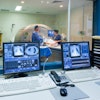Magnetic resonance spectroscopy imaging (MRSI) has been used as an analytical tool in organic chemistry, biology, and materials science for more than a half-century. Recent advances in the clinical application of MRSI are allowing radiologists to more effectively diagnose lymphoma, head and neck cancers, and brain tumors, as well as to understand metabolic brain anomalies such as stroke and dementia. However, the long scan times associated with the technique can make clinicians reluctant to conduct multislice or 3-D proton MRSI studies.
"For example, if you have a repetition time of two and you want to play out 32 x 32 phase-encoding steps, that comes out to a half-hour of scan time," said Peter Barker, Ph.D., in a presentation at the 2001 RSNA scientific assembly in Chicago.
Barker and his colleagues at the division of radiology at Russell H. Morgan Hospital in Baltimore said they believe they have found a method to reduce the scan time of MRSI, while still maintaining reasonable signal-to-noise (S/N) ratios, high-quality spectra, and unaltered spatial resolution. Their technique to reduce scan time in multislice MRSI utilizes both reduced fields-of-view (FOV) and fewer phase-encoding steps.
Conventional MR imaging measures signals emitted by hydrogen (proton) nuclei from small pixels that have been selected by spatial variations in frequency and phase. However, when using frequency changes for spatial encoding, the ability to discriminate some information about the chemical environment among the nuclei is lost.
MRSI can extract information about chemicals that reside on the frequency scale between water and fat in both a qualitative and quantitative manner. MRSI uses the same principles as MR. Rather than generating an image, however, MRSI draws a plot representing the chemical composition of a region.
Because different chemicals produce different types of spectra, the plot of their concentrations can be used to discern metabolism. Thus, measuring the intracellular concentrations of protons and estimating the concentrations of common chemicals can provide characterizations of normal and abnormal functionality.
The Russell H. Morgan team reviewed three protocols for MRSI scan time at their facility. All of the procedures were performed on a healthy 21-year-old man and were conducted using a 1.5-tesla Gyroscan ACS NT MR scanner (Philips Medical Systems, Bothell, WA). A 3-slice spin-echo proton MRSI with outer-volume lipid suppression and chemical shift-selective imaging sequence (CHESS) water suppression was recorded.
The first procedure used a standard transmit-receive head coil and was performed using a FOV of 240 x 240 mm, 15-mm slice thickness, 2.5-mm gap, a repetition time (TR) of 2,000 milliseconds (msec), an echo time (TE) of 280 msec, and a circular phase-encoding scheme (matrix) of 28 x 28 steps. These parameters resulted in a scan time of 20.5 minutes.
The team then conducted a second MRSI with the same transmit-receive head coil using a FOV of 240 x 16.3 mm and a 28 x 19 matrix, which resulted in a 13.4-minute scan time. The third MRSI utilized a prototype 3-element phased-array head coil, with a FOV of 240 x 120 mm and a 28 x 14 matrix, and resulted in a scan time of 10.2 minutes.
Data from the three acquisitions were then processed using software developed at the institution The FOV phased-array data from the third MRSI study was reconstructed according to a modified sensitivity encoding (SENSE) algorithm, Barker said.
He and his colleagues compared the S/N ratios for selected regions of interest from the acquisitions and found them to be 43:1 for the conventional 28 x 28 MRSI, and 33:1 for the 28 x 19 MRSI. Barker reported that in the 28 x 14 MRSI, S/N varied spatially as the team expected it would, and ranged from 58:1 to 24:1, depending on the proximity of the phased-array coils.
Barker told the audience that the use of the 3-element phased-array head coil allowed parallel data streams that were used to decrease image acquisition times. He also noted that when the FOV is smaller than the dimensions of the human head, multiple coil arrays and SENSE reconstruction is required. In addition, he reported that the S/N reductions associated with shorter scan times are partially offset by the higher sensitivity of the phased-array coil.
"By reducing the FOV, clinicians can either reduce scan time, or get greater brain coverage, in similar scan times as those of conventional MRSI," Barker said.
By Jonathan S. BatchelorAuntMinnie.com staff writer
December 20, 2001
Related Reading
MR tracks effects of herbal treatment for prostate cancer, June 5, 2001
Copyright © 2001 AuntMinnie.com


.fFmgij6Hin.png?auto=compress%2Cformat&fit=crop&h=100&q=70&w=100)





.fFmgij6Hin.png?auto=compress%2Cformat&fit=crop&h=167&q=70&w=250)











